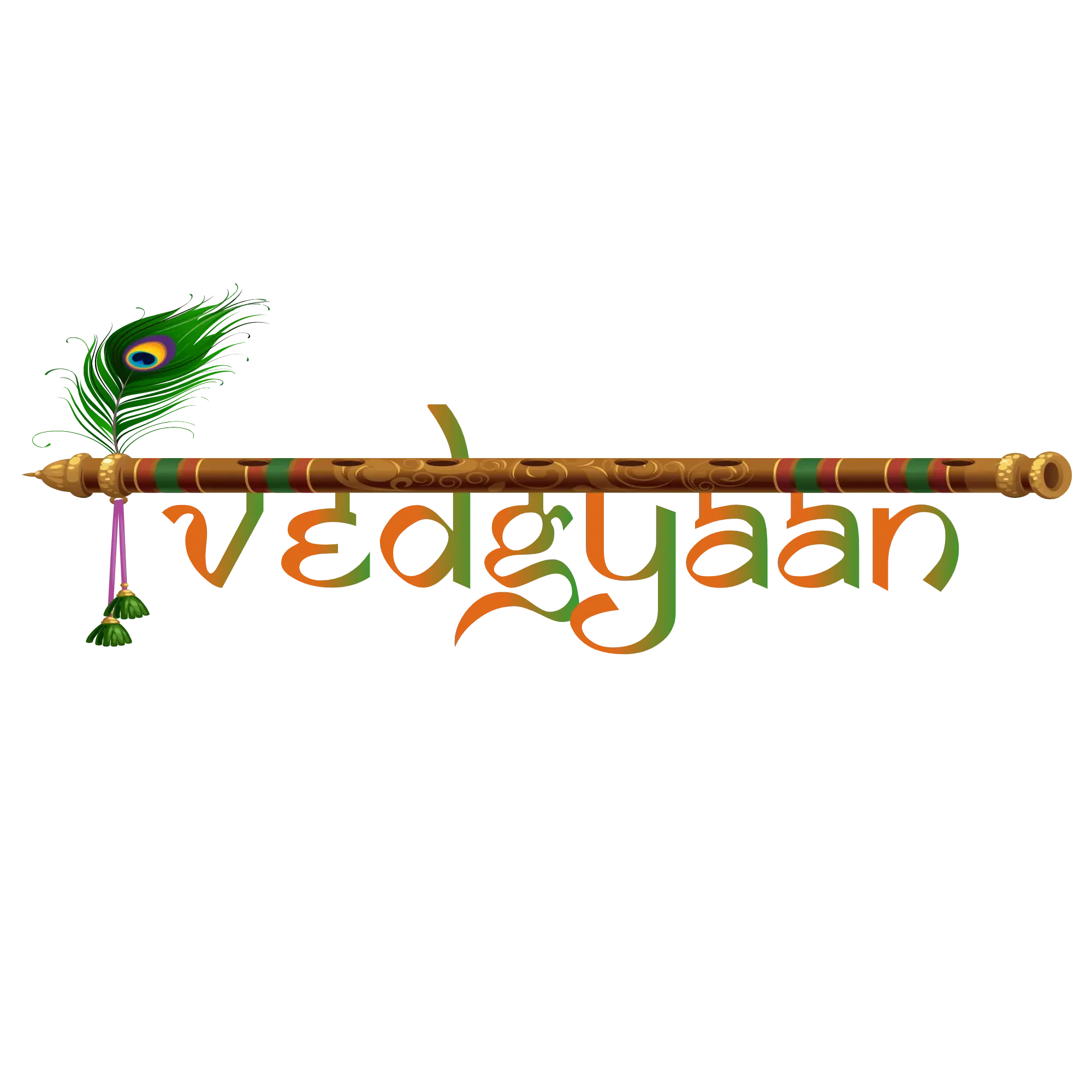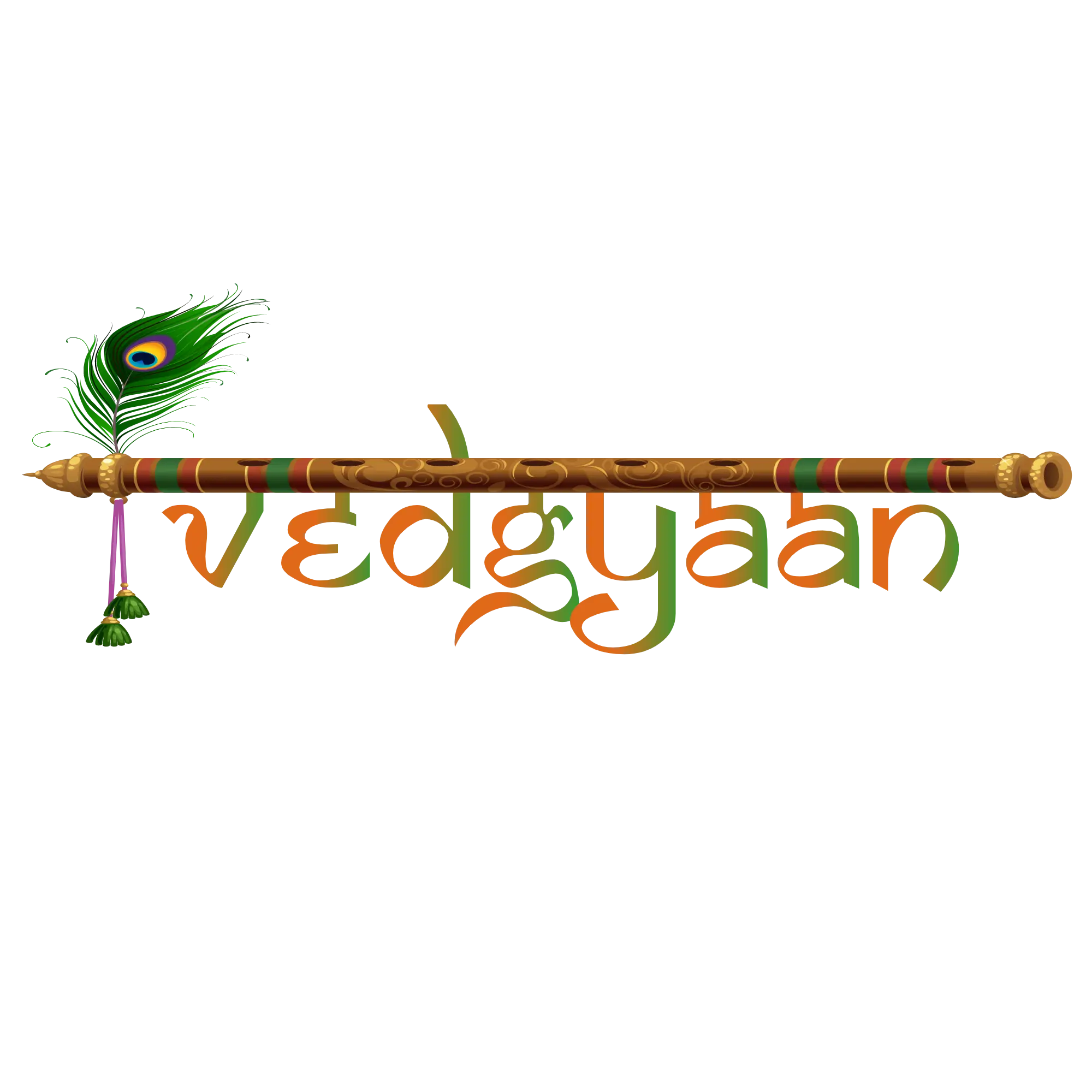The mighty protector, preserver of life itself, Lord Vishnu is one of the most powerful gods in the Hindu Pantheon – boasting the largest sect of devotees in Hinduism, Vaishnavism. The sole reason life goes on, Lord Vishnu is the essence of nature itself and has been paramount in shaping culture and society as we know it.

(Public Domain)
Who is Lord Vishnu?
Lord Vishnu, (also known as Narayana), one of the main Hindu Deities, and part of the Hindu triumvirate which also Include Brahma and Shiva. Vishnu (Sanskrit: “The Pervader”) symbolizes the preserver, the protector, and the sustainer of the world that Brahma creates and Shiva brings to an end.
Referred to as the Preserver of Good, Vishnu is somewhat of a Knight in Shining armour, often coming to the rescue and preventing the earth from cosmic destruction. Throughout Vishnu’s continuing existence, Vishnu has reincarnated himself into Dashavatar (“Ten reincarnations of Vishnu”) during dire circumstances, to restore balance and peace on earth.
Vishnu is considered to be the epitome of supreme justice, as he strongly believes in wiping out evil and spreading righteousness throughout the world. Benevolent, calm and collected, Vishnu’s sole purpose is to remain ‘The guardian of the universe’ and maintain balance. He is also considered to be the one that grants Moksha – freedom from the clutches of worldly life and entrance into the afterlife, a paradise known as Sri Vaikuntam.
Lord Vishnu is the supreme deity of the sect Vaishnavism – the largest sect in Hinduism. In Vaishnavism, Vishnu is considered to be the only all-powerful being, while all the other gods – including Brahma and Shiva – are considered ‘lesser’ gods. In Vaishnavism, Lord Vishnu is praised as the Supreme Controller of the Universe.
One of the most well-known aspects of Lord Vishnu’s life is his unconventional abode. Lord Vishnu dwells in the paradisiacal celestial land of Vaikuntam, where he lays on a bed formed by a thousand-headed serpent – named Adishesha – floating on milky waters. In Vaikuntam, Lord Vishnu lives with his consort Laxmi – Goddess of Wealth.
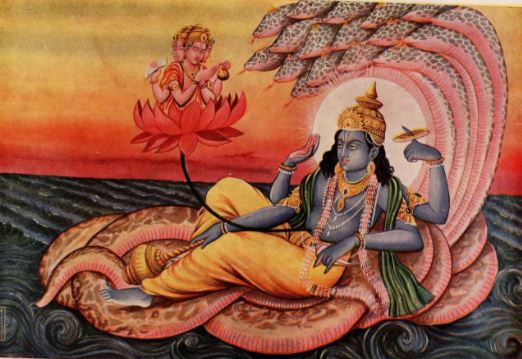
(Public domain)
Epithets: Popular Names of Lord Vishnu
Lord Vishnu is known by a plethora of names, many of which depict his different avatars. Most popularly, Lord Vishnu is known by the names Narayana, Hari, Jaganath and Govinda. The name Vishnu is a Sanskrit term meaning ‘All-pervasiveness.’
- Narayana
Lord Vishnu is commonly referred to as ‘Narayana’, which is a Sanskrit word which implies ‘He who is in a yogic slumber atop celestial waters’. This refers to Vishnu’s form when he is resting on Adishesha in Vaikuntam. Lord Vishnu often refers to himself as Narayana, The Eternal and the Unchangeable. Narayana is also a term used to describe Vaikuntam as the ultimate goal of all living beings.
- Hari
Hari is a Sanskrit word that means ‘Remover of sins and sorrows’. Lord Vishnu is widely regarded as the Preserver of righteousness, and one of his main roles is to eliminate darkness and evil from the world, earning him the title of ‘Hari’.
- Jaganath
Jaganath is derived from the Sanskrit words ‘Jagat’ meaning the Universe and ‘Natha’ meaning ‘The master of’. One of Vishnu’s alternative names, Jagannath is considered to be an abstract form of Lord Krishna.
Legend says that when Lord Krishna was killed, his celestial body ascended to Vaikuntam, whereas a human version of his body remained on earth, mummified. This version of Krishna is referred to as Jagannath and is considered to be the only form of Vishnu presiding over the earth during the ongoing Kali Yuga.
- Govinda
Govinda is a name derived from Sanskrit which directly translates to ‘Protector of the Land’. Govinda is one of the alternate names given to Lord Krishna as he is the source of power and protection.
In the Mahabharata, It is said that Vishnu restored the earth to its rightful position after it had been sunk into the depths of the ocean, and therefore the Devas started praising him with the title ‘Govinda’ or ‘Protector’.
Origin of Lord Vishnu
Although origin stories regarding Lord Vishnu’s existence are abundant, the most common belief is that Lord Vishnu is eternal, and was never ‘born’, but rather always existed. Lord Vishnu is considered to be the life-essence of the Universe, as it is said that all creation emanates from him. He is considered as ‘Omkara’ with no beginning or end. It is said that Lord Vishnu is the creator of time and space and the universe as we know it.
It is said that Lord Brahma was Vishnu’s very first creation. Although all life emanates from Lord Vishnu, he required someone to create specific lifeforms and hence created Brahma. As for Lord Shiva, although the common belief is that he has also existed before time and space, Devotees of the sect Vaishnavism believe that even Shiva was born from Lord Vishnu – emerging from his forehead when he needed a deity to bring life to a close.
Vishnu’s position as the creator of the universe is also mentioned in the Rig Veda, which states that Vishnu is the Supreme Head, and all the gods worship him at his feet. The Puranas, Vedas and Itihas also refer to Vishnu as The creator – The one who is born from no-one yet gives birth to everyone.
However, In the Shiva Puranas, it is said that Lord Vishnu originated from Shiva. It is said that one day when Lord Shiva rubbed nectar on his ankle, Lord Vishnu was created, emerging from Shiva’s body.
In a more complex take, It is believed by many that there is only one supreme god of the universe known as Parambrahma, an entity lacking any physical characteristics. All the three Gods of the triumvirate are said to emanate from Parambrahma, manifesting in the universe at different times during different cycles. As per Hindu belief, the universe regenerates in cycles, with a different triumvirate god manifesting first in each cycle. Regarding the current universe cycle, Lord Vishnu is said to have manifested first, followed by Brahma and Shiva.
Iconography: What does Vishnu Look Like?
Lord Vishnu is always depicted as a man with dark blue skin and four arms. He is seen to be carrying four objects in his arms, each of which reflects an inherent quality of his. The objects include a conch, a lotus, a chakra and a mace. Vishnu is also commonly depicted with his wife Laxmi, standing on a Lotus.
- Vishnu’s Blue Skin
Vishnu is said to have blue skin as it reflects the colour of the sky – symbolizing his deep connection with the cosmos. His blue skin is also associated with his deep connection with the Gods of rain and thunder. It is an ode to his connection with Earth – The Blue Planet.
- Vishnu’s Conch Shell
Vishnu’s Conch Shell is the greatest symbol of creation in existence. The creation of the universe is said to have been set into motion by the sound ‘Om’ – a sound that Vishnu produced on his Conch Shell.
- Vishnu’s Sudarshan Chakra
Vishnu’s chakra is a weapon of sorts, referred to as ‘The disk of auspicious visions’. It is also known as Vishnu’s ‘Wheel of Time’, and also doubles as a powerful weapon capable of destroying demons and all evil.
- Vishnu’s Padma (Lotus)
The Lotus is often revered as a sign of divinity and immortality. Lord Brahma is said to have been born from a lotus that emerged from Lord Vishnu’s navel, signifying glory, freedom and the birth of righteousness.
- Vishnu’s Mace
Vishnu’s mace is considered to be a symbol of immense power and strength. It also draws a parallel with time – precisely how time cannot be conquered, neither can the mace.
Dashavatar: Ten Incarnation of Lord Vishnu
As the Lord of Righteousness and Restorer of Karma, Lord Vishnu’s sole purpose is to preserve life on earth. Lord Vishnu is considered to be ‘The Saviour’, and at the first sign of trouble, he would reincarnate on Earth in the form of various Avatar, to restore balance.
Lord Vishnu is known to have 10 avatars, each appearing on earth during a different crisis. To date, only 9 of his avatars have visited Earth.
1.Matsya (Sanskrit: The Fish)
‘Matsya’ or The Great Fish was Vishnu’s very first avatar. When Manu, the first human, was stuck in a devastating flood, Vishnu turned himself into the fish Matsya and saved Manu’s life.
2.Kurma (Sanskrit: The Tortoise)
‘Kurma’ or The Giant Tortoise visited Earth to save Mandrachala the mountain. Mandrachal was used to churn the Ocean. However, due to the unfathomable depth of the ocean, Mandrachala began to drown. Hence, to save Mandrachal, Vishnu turned himself into the giant tortoise Kurma and carried the mountain on his back.
3.Varaha (Sanskrit: Boar)
‘Varaha’ or the Wild Boar was Vishnu’s third avatar. One day, the demon Hiranyaksha dislodged the Earth and pushed it into the bottom of the sea, causing Vishnu to turn himself into a wild boar and return Earth to its rightful place.
4.Narasimha (Sanskrit: Man-Lion)
Arguably one of Vishnu’s most clever avatars, Narasimha was half-lion, half-human. A demon named Hiranyakashipu had come in possession of a boon that granted him a wish – that he would be unkillable by any man or animal, during the day or at night, inside the house or outside the house, and by any weapon. As a result, Vishnu turned himself into Narasimha, and killed the demon at dusk, at the threshold of his house, using his hands.
5.Vamana (Sanskrit: Small or Short)
During the Treta Yuga’, or the second age, Demon-king Mahabali owned three worlds or kingdoms. Vishnu incarnated himself as the Brahmin Vamana to trick Mahabali. Vamana visited Mahabali as a short Brahmin and asked him to spare him three feet of land. A Generous king, Mahabali agreed – following which Vamana grew in size, claiming his entire kingdom. When there was no more land left, Mahabali offered his head, and Vamana stepped on it.
6. Parashurama (Sanskrit: Warrior with Axe)
Vishnu incarnated himself as ‘Parashurama’, a Brahmin, to rid the world of unrighteous and cruel rulers. Wielding Lord Shiva’s Axe, he had the ability to destroy the world.
7.Lord Rama (Sanskrit: One in search of Enlightenment)
Vishnu’s most famous avatar, Lord Rama was the ‘Puroshottam’, or the Perfect Man. He was the epitome of righteousness and was born the prince of Ayodhya. He was born during the ‘Treta Yuga’ or the second age and was sent to Earth to defeat the evil multi-headed demon king Ravana.
The Ramayana is the story of Lord Ram, his wife Sita and his brother Laxman. Exiled from the kingdom of Ayodhya, they set off into the forest for fourteen years. During this period, Sita was kidnapped by Ravana – prompting Ram to travel to Lanka, Ravana’s abode, find him and kill him, serving his purpose on Earth.
8.Lord Balarama (Sanskrit: Strong Rama)
Visnu’s eighth avatar, he returned to earth during his 9th war as Balrama, Lord Krishna’s oldest brother. Balrama was strongly associated with farming, often using farming equipment as his weapons. He is considered to be the physical representation of Vishnu’s serpent form Sesha. Balarama also was known for teaching Bhima and Duryodhana the art of fighting with a mace.
9. Krishna (Sanskrit: Dark Skinned or Dark Blue)
The Last avatar to arrive on earth was Lord Krishna. Krishna is one of the most significant avatars of Lord Vishnu, and he played a significant role in the Mahabharata. Krishna had two main purposes during his time on earth – to defeat his evil uncle Kansa, and to act as a mentor to the Pandavas in the Mahabharata. He was born during the Dwapara Yuga- The Third Age.
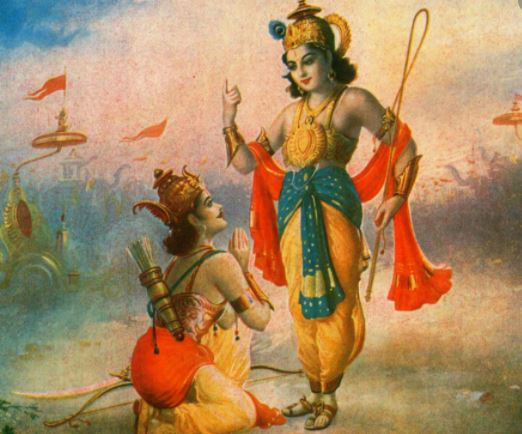
(Public domain)
10.Kalki(Sanskrit: Destroyer of Filth)
Yet to make an appearance on Earth, Kalki is said to be Vishnu’s final avatar. Said to arrive at the end of the ‘Kali Yuga’ or the Last Stage (Current Yuga), Lord Vishnu will present himself on a white horse with a powerful sword to rid the world of all evil. This will mark the end of this cycle and the start of the next four ‘Yugas’.
Vishnu And Laxmi
The story of Lord Visnu and Laxmi’s courtship began with Lord Indra and a curse. Lord Indra, the King of the Devas, was a powerful god, but an arrogant one. One day, while he was riding on his elephant Airavata, he encountered a powerful sage. Seeing Lord Indra, the sage offered him his sacred garlands, as a show of respect. Lord Indra however, treated the garlands carelessly, throwing it to the ground. Enraged by his disrespect, The sage cursed Indra and all the Devas to slowly lose their power and grow tired and helpless.
Terrified of now being vulnerable in the fight against the ‘Asuras’ or the demons, the Deva’s pleaded to Vishnu for his help. Vishnu was unable to reverse the curse but suggested that the Deva’s churn the ocean and obtain Amrit (Sanskrit: The nectar of strength and immortality) and this episode in Hindu Mythology narrated in the Bhagavata Purana came to known as Samudra manthan.
Churning the Samudra (Sanskrit: Ocean) required a large amount of effort, and with the promise of having a share of the Amrita, the Asuras teamed up with the Devas and set off to work. In the course of churning the ocean, many powerful beings started to emerge – including the Kamadhenu cow, Uchaishravas horse and Kalpavriksha tree. Last to emerge from the ocean was the beautiful deity of wealth and prosperity – Goddess Laxmi. All the Asuras and Devas were smitten by her beauty, and stood in line, waiting for her to choose a husband.
However, Laxmi’s eyes fell on Lord Vishnu, and she immediately fell in love with him, choosing him as his suitor. Vishnu and Laxmi went on to be married, and they came to be known as the most powerful couple among the Hindu pantheon. Laxmi remained as Vishnu’s eternal wife and is known for spending her life devoted to him and tending to him.
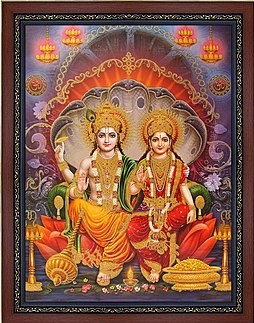
(Public domain)
Vishnu’s Significance in Hinduism
Lord Vishnu is the most important and most worshipped among the entire Hindu pantheon. He is widely referred to as the Preserver, Protector and the Saviour, which are considered to be his sole duties. Vishnu is the very source behind life itself and is responsible for its upkeep. He is the protector of Dharma – The essence of nature, the cosmic law of social order and justice that dictates life. Hindu’s worship him to maintain the balance in their lives and to preserve their Dharma.
An extension of Dharma is Moksha. Freedom from the birth cycle and entrance into paradise said to be Lord Vishnu’s abode, Moksha is a reward for practising strict Dharma throughout one’s life. Being the gatekeeper of Moksha, Lord Vishnu is worshipped and invoked to grant Moksha to all his devotees – fulfilling their life-long goal. Lord Vishnu is also widely associated with the Hindu rite of Sacrifice – imparting his power and enlightenment to his devotees who practice it.
In addition to his Hindu devotees, Vishnu is also worshipped by a special sect of Hindus called Vaishnavites. Vaishnavites practice Vaishnavism – in which Lord Vishnu is titled the Controller of the universe. They solely worship Lord Vishnu and his avatars – especially Lord Krishna and Lord Ram – for prosperity, good karma, enlightenment and protection from evil.
The harbinger of all that is good, Vishnu abhors evil and makes it his life mission to rid the world of it, which is the main reason he routinely incarnates himself as an avatar and returns to Earth during times of moral crisis.
In Vaishnavism, the main literature is the Vishnu Purana – a collection of all of Lord Vishnu’s significant exploits. It details how Lord Vishnu is the most powerful and benevolent, and also credits him with providing the gift of immortality to the Devas. It also consists of stories detailing the lives and achievements of all of Vishnu’s avatars.
In a bid to celebrate or worship Lord Vishnu further, Thursday is known as the ‘Day of Vishnu’ – an entire day devoted to Lord Vishnu and his avatars. It is actively observed by his Hindu devotees, who fast throughout the day and make offerings in the form of milk and ghee to show their undying devotion and gratitude to Vishnu and the life that emanates from him.
However, Lord Vishnu is considered to be hard to please. Unlike the other gods, Vishnu is not easily flattered by big pujas or offerings if the intentions are solely to receive worldly pleasures such as materialistic items or wealth. Lord Vishnu believes that every human’s true home is Vaikuntam or Paradise, and therefore, his main intention is to guide his devotees towards achieving Moksha. Hence, Lord Vishnu is only pleased when the main intention of the devotee is to achieve Moksha.
Festivals Celebrating Lord Vishnu
A variety of festivals are celebrated in honour of Lord Vishnu and his avatars every year. These festivals include Diwali, Gokul-Ashtami, Holi, Nag Panchami, Ram Navami, and so on.
- Diwali
Diwali, The Festival of Lights, is one of the most widely celebrated festivals today and it takes place on the first night of the full moon after the festival Dussehra. Diwali commemorates the return of Lord Ram to Ayodhya after fourteen years and devotees celebrate by lighting lamps and bursting crackers.
The night of the full moon is also a night of worship, during which devotees welcome Lord Vishnu and Laxmi into their homes – to bring prosperity and to drive away evil.
- Gokul-Ashtami
Gokul-Ashtami commemorates the arrival of Vishnu on earth in the form of Krishna. Followers conduct late-night prayers, and decorate idols of Lord Vishnu with flowers and jewellery, and gather in groups to recite the tale of Vishnu’s arrival as Krishna.
- Nag Panchami
It is the festival of snakes, during which Cobras are worshipped and fed milk. Snakes are celebrated as they are the earthly representatives of the great celestial snake Ananta-Sesha, who rids the world of pests and maintains the earth’s fertility.
- Holi
It is the festival of colours and is celebrated to commemorate the birth of Lord Vishnu and Laxmi’s son Mandana – God of Pleasure. It marks the beginning of spring and is a festival of love and joy. Devotees rub colour on one another, filling the streets with laughter and happiness.
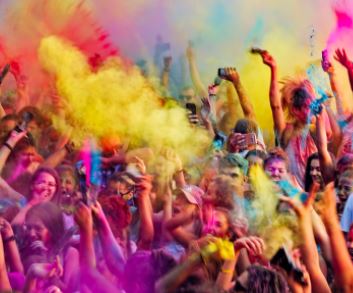
(Public domain)
- Ram Navami
Ram Navami is the festival of Lord Ram, Vishnu’s seventh avatar. The recital of the Ramayana begins a week before the day of Ram Navami, and prayers are conducted in temples and at home.
The epitome of righteousness, Lord Vishnu poses one of the most important lessons we as humans must learn –
Good always triumphs over evil. Lord Vishnu teaches us that it is imperative to never sway from the path of righteousness and truth, and that evil must always come to an end.
